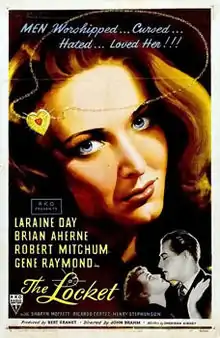The Locket
The Locket is a 1946 film noir directed by John Brahm, starring Laraine Day, Brian Aherne, Robert Mitchum, and Gene Raymond, and released by RKO Pictures. The film is based on a screenplay by Sheridan Gibney, adapted from "What Nancy Wanted" by Norma Barzman, wife of later-blacklisted writer Ben Barzman. It is noted for its complex and confusing use of layered flashbacks within flashbacks) to give psychological depth to the narrative.
| The Locket | |
|---|---|
 Theatrical release poster | |
| Directed by | John Brahm |
| Produced by | Bert Granet |
| Written by | Sheridan Gibney |
| Starring | Laraine Day Brian Aherne Robert Mitchum Gene Raymond |
| Music by | Roy Webb |
| Cinematography | Nicholas Musuraca |
| Edited by | J.R. Whittredge |
Production company | RKO Pictures |
| Distributed by | RKO Pictures |
Release date |
|
Running time | 85 minutes |
| Country | United States |
| Language | English |
| Box office | $1,750,000 (US)[2] |
Summary
A story told in a number of flashbacks from different points of view, this psychological drama tells the story of a bride-to-be (Day) who, as a child, was falsely accused of theft. She grows up to become a kleptomaniac, inveterate liar, and eventually a murderess.[3] As an adult, she has several relationships with weak-minded men who allow her to ruin their lives.
Apparently, all her misdeeds are an attempt to get revenge on the world by ruining people's lives after she was falsely accused of stealing as a child. After splitting up with an artist (Mitchum), ending with him committing suicide, and her psychiatrist husband (Aherne), causing him to enter a mental institution as a patient, she becomes engaged to the son (Raymond) of the woman who had accused her of thievery. Back in the present day, at her wedding, the young woman collapses physically and mentally as she walks to the altar and she is committed to a mental institution.
Cast
- Laraine Day as Nancy Monks Blair Patton
- Brian Aherne as Dr. Harry Blair
- Robert Mitchum as Norman Clyde
- Gene Raymond as John Willis
- Sharyn Moffett as Nancy, age 10
- Ricardo Cortez as Drew Bonner
- Katherine Emery as Mrs. Willis
- Helene Thimig as Mrs. Monks
- Reginald Denny as Mr. Wendell
- Nella Walker as Mrs. Wendell
- Henry Stephenson as Lord Wyndham
- Lillian Fontaine as Lady Wyndham
- Myrna Dell as Thelma
- Wyndham Standing as Butler (uncredited)
Background
- Hume Cronyn originally bought the Norma Barzman screenplay to produce and direct the film with his wife Jessica Tandy in the lead role, but later sold the rights to RKO Pictures, which then assigned Gibney to rewrite the screenplay. The original Barzman screenplay is in the Cronyn-Tandy papers at the Library of Congress.
- The interiors used for the house of Mrs. Willis are clearly the same as those used for the house of Alex Sebastian (Claude Rains) in Alfred Hitchcock's Notorious, released by RKO in September 1946.
Reception
Critical response
When the film was released the staff at Variety magazine praised the film, writing, "Story carries the flashback technique to greater lengths than generally employed. The writing by Sheridan Gibney displays an understanding of the subject matter and proves a solid basis for the able performances achieved by John Brahm’s direction. Latter gears his scenes for full interest and carefully carries forward the doubt – and audience hope – that Nancy is not the villainess."[4]
Film historians Alain Silver and Elizabeth Ward praise the unusual melodrama in the RKO visual style. "It is distinctive in its flashbacks within flashbacks, with the story often being told by a third or fourth person removed. This device is handled effectively in preparation for the climactic flashback, which reveals the truth."[5]
Film critic Dennis Schwartz gave the film a mixed review, writing, "A psychological drama about a woman with a dark secret from her childhood that is carried over to her adult life. It's a post-war baroque melodrama, creaky as wooden steps in a mildewed house ... It was too wooden a presentation to generate anything but a few sparks ... It's a somber story, with a lot of heavy-handed things going on. The complexities of the heroine's character were well presented. The analyst's comments about her stealing to get even with Mrs. Willis seemed to be a reasonable explanation, if taken at face value ... The Locket only had some glitter but not enough substance. Though, as muddled as it was, it still kept me alert wanting to know what gives. The problem is I never satisfactorily found out what gives."[6]
References
- "The Locket: Detail View". American Film Institute. Retrieved April 30, 2014.
- Variety (8 March 2018). "Variety (January 1948)". New York, NY: Variety Publishing Company – via Internet Archive.
- Miller, Frank. "The Locket". TCM.com. Turner Classic Movies. Retrieved 2 September 2018.
- Variety Staff (1 January 1947). "The Locket".
- Silver and Ward, Film Noir An Encyclopedic Reference to the American Style, The Locket, page 173. The Overlook Press, 1992. ISBN 0-87951-479-5.
- Schwartz, Dennis. "locket". homepages.sover.net.
Bibliography
- George Toles, "The Gift of Amnesia in John Brahm's The Locket" in the Film and the Romantic special issue, Jeffrey Crouse (ed.), Film International, Vol. 7, No. 6, December 2009, pp. 32–55.
External links
- The Locket at IMDb
- The Locket at AllMovie
- The Locket at the TCM Movie Database
- The Locket informational site and DVD review at DVD Beaver (includes images)
- The Locket analysis by author Wheeler Winston Dixon at Film Noir of the Week
- The Locket film clip on YouTube